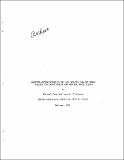| dc.description.abstract | There is a projected shortage of water supply for evaporative cooling
in electric power industry by the end of this century, Thus, dry and
wet/dry cooling tower systems are going to be the solution for this
problem. This study has determined the cost of dry cooling compared to
the conventional cooling methods. Also, the savings by using wet/dry
instead of all-dry cooling has been determined.
A total optimization has been performed for power plants with dry
cooling tower systems using metal-finned-tube heat exchangers and surface
condensers. The optimization minimizes the power production cost.
The program does not use pre-designed heat exchanger modules.
Rather, it optimizes the heat exchanger and its air and water flow rates.
In the base case study, the-method of replacing lost capacity
assumes the use of gas turbines. As a result of using dry cooling towers
in an 800 MWe fossil plant, the incremental costs with the use of high
back pressure turbine and conventional turbine over all-wet cooling are
11% and 15%, respectively. For a 1200 MWe nuclear plant, these are 22%
and 25%, respectively.
Since the method of making up lost capacity depends on the situation
of a utility, considerable effort has been placed on testing the effects
of using different methods of replacing lost capacity at high ambient
temperatures by purchased energy. The results indicate that the optimization
is very sensitive to the method of making up lost capacity. It is, there-
fore, important to do an accurate representation of all possible methods
of making up capacity loss when optimizating power plants with dry cooling
towers.
A solution for the problem of losing generation capability by a
power plant due to the use of a dry cooling tower is to supplement the
dry tower during the hours of peak ambient temperatures by a wet tower.
A separate wet/dry cooling tower system with series tower arrangement
has been considered in this study. In this cooling system, the physical
separation of the dry and wet towers protects the dry tower airside heat
transfer surface from the corrosion problem. It also allows complete
freedom of design and operation of the dry and wet towers. A wet/dry
cooling system can be tailored to meet any amount of water available for
cooling. The results of the optimization show that wet/dry cooling towers
have significant savings over all-dry cooling, For example, in either
fossil or nuclear plant, the dry tower heat transfer surface of 30% makeup
water wet/dry cooling system is only about fifty percent of that in all-dry
cooling using high back pressure turbines. This results in a reduction of
27% and 37% of the incremental cost in the fossil and nuclear plant,
respectively, over all-wet cooling. Even the availability of a small
percentage of makeup water reduces the incremental cost significantly.
Thus, wet/dry cooling is an economic choice over all-dry cooling where some
water is available but supplies are insufficient for a totally evaporative
cooling towers. On the other hand, the advantage of wet/dry cooling over
evaporative towers is conservation of water consumption. | en |
